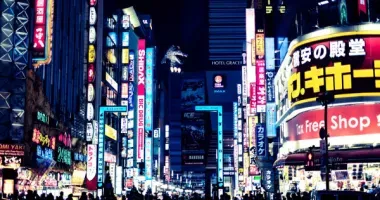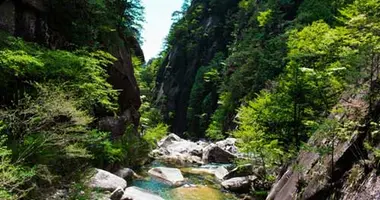Tocho Observation Decks: Tokyo's free panoramic viewpoints

Tokyo Metropolitan Government Omoide Piano, created in collaboration with Yayoi Kusama
Perched atop the iconic Tokyo Metropolitan Government Building in Shinjuku, the Tocho Observation Decks offer visitors a breathtaking panoramic view of Tokyo's sprawling cityscape. These free-to-access observatoriesprovide an unparalleled opportunity to witness the beauty of Japan's capital from 202 meters above ground. Designed by renowned architect Kenzo Tange, the twin towers of Tocho have become a symbol of Tokyo's modernity and administrative power. As you ascend to the 45th floor, prepare to be amazed by the stunning vistas that stretch as far as the eye can see, encompassing famous landmarks and the dynamic urban landscape that defines Tokyo.
Overview of the Tokyo Metropolitan Government Building observatories
The Tokyo Metropolitan Government Building, affectionately known as "Tocho," houses two distinct observation decks in its North and South Towers. Standing at a height of 243 meters, this impressive structure has been a prominent feature of the Shinjuku skyscrapers since its completion in 1990. The building splits at the 33rd floor, forming two separate towers that reach up to 48 stories. On the 45th floor of each tower, at a height of 202 meters, visitors can access the free observation decks that offer panoramic views rivaling those of paid attractions like Tokyo Skytree and Tokyo Tower.
These observatories serve a dual purpose: they not only provide spectacular views but also aim to educate visitors about Tokyo and its governance. As you gaze out over the metropolis, you're encouraged to contemplate the future of Tokyo and learn about the city's policies and administration. The observatories are equipped with informational displays and often host exhibitions related to urban planning and development.

Tokyo Metropolitan Government Building (Tocho), Shinjuku, Tokyo
Access and visiting information for the Tocho observation decks
Accessing the Tocho observation decks is straightforward and convenient. Visitors can reach the building via Tocho-mae Station on the Toei Oedo Subway Line, exiting at A4. Alternatively, it's a 10-minute walk from the west exit of JR Shinjuku Station. Once inside, take the dedicated "Observatories Elevator" from the first floor of the No. 1 Building to reach the observatories.
The South Observatory is open from 9:30 AM to 10:00 PM (last admission at 9:30 PM), while the North Observatory operates from 9:30 AM to 5:30 PM (last admission at 5:00 PM). It's important to note that each observatory has different closing days: the South Observatory is closed on the first and third Tuesday of every month, while the North Observatory closes on the second and fourth Monday. When these days fall on a holiday, the observatories remain open but close the following day. General Information about opening hours, closures, and special dates can be found on the official website.
Spectacular views from the north and south observatories
From the Tocho observation decks, visitors are treated to breathtaking 360-degree views of Tokyo's skyline. On clear days, the panorama extends far beyond the city limits, offering glimpses of iconic landmarks and natural wonders. Looking northeast, you can spot the towering Tokyo Skytree dominating the horizon. To the southeast, the lush greenery of Shinjuku Gyoen and the sacred grounds of Meiji Jingu stand out amidst the urban landscape.
The southwest direction reveals the impressive silhouettes of Shinjuku Park Tower and Tokyo Opera City Tower, showcasing the city's modern architectural marvels. Perhaps the most awe-inspiring sight is to the west, where on clear days, especially between December and February, visitors can catch a glimpse of the majestic Mount Fujirising above the distant horizon. These diverse viewpoints offer a comprehensive overview of Tokyo's geography and urban development, making the Tocho observatories a must-visit destination for both tourists and locals alike.

View from the Tocho South Tower Observation Deck over the Tokyo skyline towards Tokyo Sky Tree

View from the Tocho South Tower Observation Deck towards snow-capped Mount Fuji on a sunny but hazy day
Unique features and facilities at the Tocho observation decks
The Tocho observation decks offer more than just stunning views; they provide a range of unique features and facilities to enhance the visitor experience. One of the most notable additions is the Piano Designed by Yayoi Kusama, located in the South Tower Observatory. This vintage piano, donated by Tokyo residents, was transformed into a vibrant work of art by the renowned Japanese artist Yayoi Kusama. Covered in her signature polka dot pattern, the piano adds a splash of color and creativity to the observatory.
Visitors are encouraged to play the Kusama piano during designated hours, creating a unique interactive experience. The South Observatory also features a large gift shop and café, allowing visitors to enjoy refreshments while taking in the panoramic views. For those seeking more information about the sights, QR code information panels are available in multiple languages, providing details about the visible landmarks and points of interest. Additionally, both observatories occasionally host special exhibitions and events, offering insights into Tokyo's culture, history, and future plans.

Tokyo Governor Yuriko Koike with the piano collaborated by Yayoi Kusama, Tocho South Tower Observation Deck, Shinjuku
Best times to visit and photography tips
To make the most of your visit to the Tocho observation decks, timing is crucial. For breathtaking daytime views, consider visiting on a clear day, preferably in the morning when visibility is often at its best. Winter months, particularly December to February, offer the best chances of spotting Mount Fuji due to clearer atmospheric conditions. For those seeking a romantic evening atmosphere, visiting around sunset allows you to witness the transformation of Tokyo from a bustling daytime metropolis to a glittering sea of lights.
Photography enthusiasts will find plenty of opportunities to capture stunning images. To avoid reflections on the glass, position your camera close to the windows. For night photography, a tripod is recommended, but be aware that the use of large professional equipment may be restricted. Consider using a wide-angle lens to capture the expansive cityscape. Don't forget to experiment with different angles and focal points, such as focusing on specific landmarks or capturing the intricate patterns of Tokyo's urban layout. Remember to check the weather forecast before your visit to ensure optimal visibility for your photographic endeavors.
Cultural significance and educational aspects of the Tocho observatories
The Tocho observation decks serve as more than just tourist attractions; they hold significant cultural and educational value. As the seat of the Tokyo Metropolitan Government, the building itself symbolizes the city's administrative power and its role in shaping the future of the metropolis. The observatories provide a unique platform for visitors to gain insights into urban planning, governance, and Tokyo's vision for the future.
Educational displays and exhibitions often highlight various aspects of Tokyo's development, environmental initiatives, and cultural heritage. The observatories frequently host special events and themed exhibitions, such as showcases of regional products from different parts of Japan or displays on Tokyo's preparations for major events like the Olympics. The presence of the Yayoi Kusama piano adds an artistic dimension, bridging contemporary art with public spaces. Moreover, the Piano Concert events, featuring performances by renowned artists like Tomoya Umeda, transform the observatory into a cultural venue, offering a unique blend of visual and auditory experiences against the backdrop of Tokyo's skyline.
Comparing Tocho observation decks with other Tokyo viewpoints
While Tokyo boasts several observation decks, the Tocho observatories stand out for their unique combination of accessibility, affordability, and panoramic views. Unlike paid attractions such as Tokyo Skytree or Tokyo Tower, the Tocho observation decks offer free admission, making them an excellent option for budget-conscious travelers. The dual towers provide different perspectives of the city, allowing visitors to compare views from slightly different vantage points.
Compared to higher observation points like Tokyo Skytree, the Tocho decks offer a more intimate view of the cityscape, with details of nearby buildings and streets more discernible. The location in Shinjuku, one of Tokyo's major business and entertainment districts, provides a central viewpoint of the city. While other observatories might offer higher elevations or more modern facilities, the Tocho decks' combination of historical significance, cultural value, and stunning views make them a unique and essential stop for any visitor looking to understand Tokyo's past, present, and future. For those wanting to explore more of Tokyo's diverse landscapes, the Tokyo Area Guides provide comprehensive information on other notable viewpoints and attractions across the city.




























